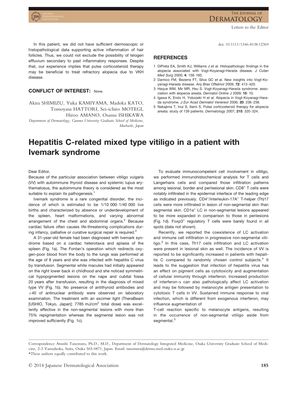Hepatitis C-Related Mixed Type Vitiligo in a Patient with Ivemark Syndrome
January 2014
in “
The Journal of Dermatology
”

TLDR A patient with Ivemark syndrome developed mixed type vitiligo after a hepatitis C infection, showing different treatment responses and immune cell involvement in the skin.
In the documented case, a 31-year-old female with Ivemark syndrome—a rare congenital disorder characterized by spleen and heart malformations—developed mixed type vitiligo after being infected with hepatitis C virus from a blood transfusion. The patient exhibited different responses to excimer light treatment between non-segmental and segmental vitiligo lesions, with over 75% repigmentation in non-segmental lesions but insufficient improvement in segmental lesions. Immunohistochemical analysis revealed a notable infiltration of CD8+ T cells and CD4+/interleukin-17A+ T-helper (Th)17 cells, as well as an expansion of CD1a+ Langerhans cells in non-segmental lesions compared to segmental ones. This suggests that hepatitis C infection may influence the immune response and contribute to the development of non-segmental vitiligo. This case is the first reported instance of mixed type vitiligo in a patient with both Ivemark syndrome and hepatitis C, indicating a coexistence of different pathological conditions in mixed vitiligo.



